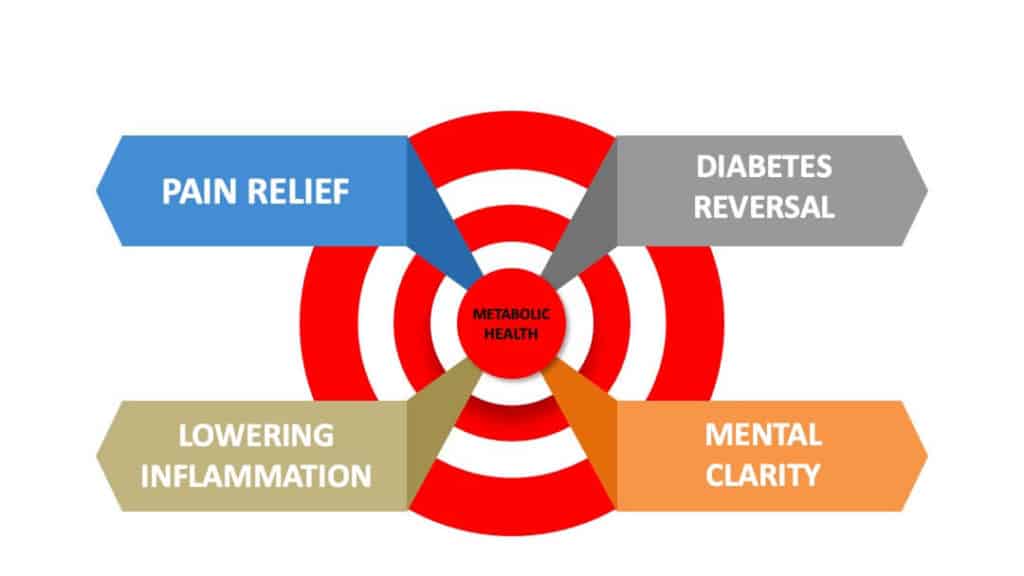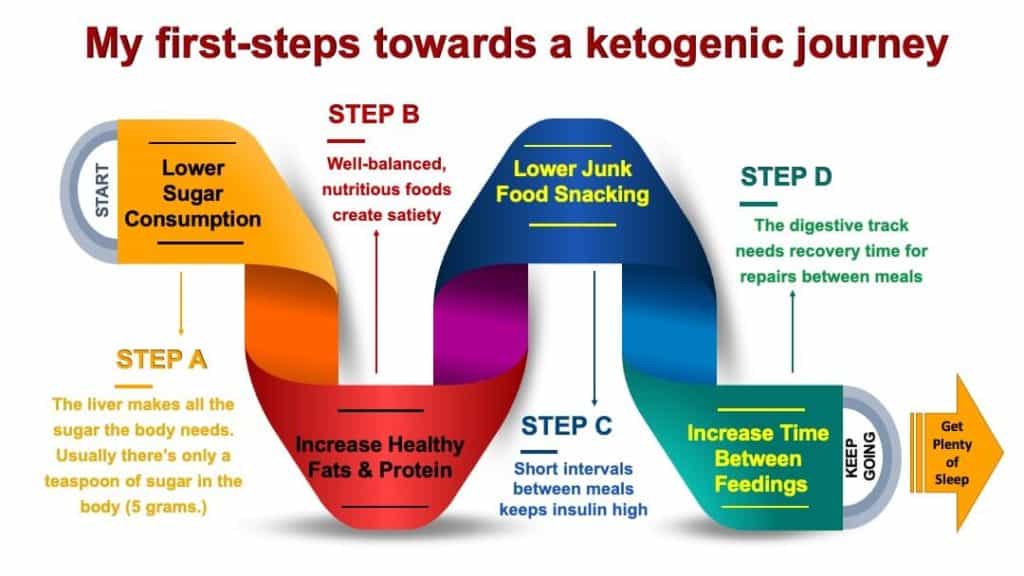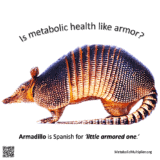Pain started my ketogenic journey (Part 1)
Searing knee pain led me to a transformative ketogenic lifestyle that restored my body to its 18-year old shape, increased my energy levels and provided mental clarity. With as much training, education and mentoring as was invested in me over a lifetime, you’d think I would have had a good handle on how my organism worked. A decade ago, I was confident I’d picked up all the skills I needed to manage my health. However, chronic knee pain that steadily intensified knocked me off that smug perch. That’s when I wished someone had given me an owner’s manual for operating my cantankerous body. What started out as a change in eating habits became a life-time of exploration, learning and adaptation. It didn’t happen in a day and I fumbled along the way.
I’ll describe the path I took in five parts
- Seeking relief from joint pain was the start
- Reversing my metabolic syndrome
- Lowering inflammation with dietary interventions
- Learning about ketosis for mental clarity
- Lastly, ameliorating my brother’s illness with a ketogenic diet.

I never intended to use a ketogenic diet. The path leading to a low-carbohydrate lifestyle was convoluted, but a life at sea predisposed me to find instruments to guide my journey. At the start I did not know what bearings to steer by. What measurements indicated success? Were there instruments that could guide me? Which necessary tests could only be performed by laboratories? Upon reflection, here is what I wish I’d known at the beginning. Perhaps reading my reflections will save you some of my hard knocks. So, let’s start at the beginning, ten years ago, with a 60 year old man.
Pain started my ketogenic journey
After I retired from the U.S. Navy in 2005, I moved to England for a few years to study history. I loved running several miles each day on the hilly terrain. But I started developing a nagging pain in my left knee. My mother had knee operations on both her knees without relief. Therefore, I resisted the urge to have a surgical procedure, but by 2010 the pain was intense. It became difficult to get a good night’s sleep and my exercise routine was disrupted.
At first weight loss was what mattered
My first thought was that my rotundity was creating excessive impact force on the knee when I ran. But then, why didn’t my right knee bother me? I reasoned that the human body is not perfectly symmetrical and a small difference in length could be provoking the discomfort. In any case, I started focusing on pounds (or stones as measured in Britain). It was sensible that extra weight would increase joint stresses, especially when running and exercising. So, if I had to lose weight, what was the expert opinion?
The best tactics for losing weight – Increasing physical activity has many health benefits and can help you shed weight. But stepping up your exercise alone is rarely enough to help you lose weight. Every pound you’d like to shed represents roughly 3,500 calories. So if you’re hoping to lose half a pound to one pound a week, you need to knock off 250 to 500 calories a day. A good way to start is to try to burn 125 calories through exercise and eat 125 fewer calories each day.
Harvard Healthbeat(1)((1. Why weight matters when it comes to joint pain. Healthbeat. Harvard Health Publishing. [accessed 2020 April 15]. https://metmult.news/a8012))
Body weight & calories meant measuring pounds & ounces
The “eat less and exercise more” idea, often referred to as the “Calories In equals Calories Out hypothesis” (CICO), seemed sensible. I started weighing myself and counting calories. Less sweets and desserts – more vegetables and fruits. Bathroom and kitchen scales became my measurement tools. Unfortunately, the CICO portion of my journey was a dead end that I blamed on too much eating and too little exercise.(2)((2. Feinman, R. D., & Fine, E. J. (2004). “A calorie is a calorie” violates the second law of thermodynamics. Nutr J, 3(1), 9. https://doi.org/10.1186/1475-2891-3-9)) I was stuck.
Quantify. If whatever it is you’re explaining has some measure, some numerical quantity attached to it, you’ll be much better able to discriminate among competing hypotheses. What is vague and qualitative is open to many explanations.
Carl Sagan(3)((3. Sagan, C. (1995). The demon-haunted world: Science as a candle in the dark. New York: Random House))
A focus on sugar meant measuring glucose
Yes, about 10 pounds came off, but my knee pain continued to increase in intensity and I was still 60 pounds over my recommended body mass index (BMI). An MRI was not revelatory. My doctor recommended surgery. So, I started researching osteoarthritis, but stopped running due to the pain. I was still focused on weight loss and concluded that less sugar consumption (less energy) would help.
Snacking less frequently
I started drinking coffee and tea without sugar. By focusing on healthy foods the urge for snacks decreased and satiety increased. However, I was not yet concerned about bread, pasta, cereal, oatmeal, rice, beer as food sources. But, I did start shifting to whole bread, brown rice, sprouted seeds and organic produce. My overall guide was the Food Pyramid and its dietary recommendations. I did not yet understand that diets are a medical intervention.(4)((4. Barnett, C. (2019 July 15). Why evaluate dietary interventions? They’re just food. Metabolic Multiplier. [Accessed 2020 April 19]. https://metmult.news/929bf))

Moderate steps led to moderate gains and less pain
This is how I started a decade ago. Moderate weight loss and increasing knee pain were my results. With few gains to show, an annual fasting glucose test came back as prediabetic ( > 100 mg/dL). The lab results didn’t bother me. My vocabulary at this point did not include blood glucose, satiety, nutritious foods, healthy fats, snacking, insulin or gut recovery. They were all just part of an attempt to eat healthily. I was not on a specific diet and did not realize I was paddling against the current. A comparison study of major diets would have told me this.(5)((5. Dansinger, M. L., Gleason, J. A., Griffith, J. L., Selker, H. P., & Schaefer, E. J. (2005). Comparison of the Atkins, Ornish, Weight Watchers, and zone diets for weight loss and heart disease risk reduction: A randomized trial. JAMA, 293(1), 43-53. https://doi.org/10.1001/jama.293.1.43))
Each popular diet modestly reduced body weight and several cardiac risk factors at 1 year. Overall dietary adherence rates were low, although increased adherence was associated with greater weight loss and cardiac risk factor reductions for each diet group.
(Dansinger 2005)
Then a series of health problems came right after the prediabetic diagnosis. The puzzling illnesses, from retinopathy to whooping cough, stressed me and caused an onslaught of discomfort that forced me to reassess my lifestyle. I was suffering from poor metabolic health. I’ll cover this struggle with diabetic complications in Part 2.
Keywords: pain, osteoarthritis, knee, diet, CICO, calorie, snacking, sugar, junk food, carbage, ultra-processed food, glucose, obesity, BMI, diabetes, metabolic syndrome
If you enjoyed reading this you might like:
- Coronavirus quarantine – how a lifetime in submarines eases my use of isolation for self-improvement.
- Diabetes Dirge, aka Diabetes for Dummies, learning to use big words to create positive health
- Raj’s journey from obese and diabetic to healthy
Fact checked by Cecile Seth.
Success stories from the our team
- Metabolic Multipliers
- Captain Malagon
- Cecile’s
- Nurse Christie – My mother’s suffering spurred me to find keto
Other resource guides & toolkits you might value
Curious about improving metabolic health with lifestyle?
- Lifestyle Medicine, the key to metabolic healing
- What is metabolic health? A layperson’s definition and a biochemist’s perspective
Where do I start improving my metabolic health?
- Your patient toolkit for prediabetes & type 2 diabetes
- What to eat? Get clever! Clinicians’ flexible approach to tailoring carb reduction to you.
- Want more detail on carbohydrate reduction? A round-up of quality, what-to-eat guides from around the web
- Best resources for an overview of keto – Metabolic Multiplier’s round up of the best resources we’ve found by evidence-based organizations & clinicians. For patients, families & caregivers.
- Keto doctors near me – over 20 directories of low-carb professionals
For clinicians using therapeutic carbohydrate reduction (TCR), ketogenic diet therapies (KDT)
- Best Keto resources for clinicians & other practitioners
- How to build my ketogenic therapy treatment team – Support for the more complex cases.
- Why write medical case reports about unique cases? – Our round up can save you time.
For colleagues interested in amplifying metabolic health
- Overview schematics help us think about metabolic health – Understand our Organizing Research team‘s thinking behind these 3 metabolic health research portals
- Communication guide to unite advocacy for metabolic health – Suggested language metabolic health advocacy. Principles. Language to use or avoid. Food & lifestyle first.
- Style Guide to unite advocacy for metabolic health – Welcome new team members! Many of you encourage using one voice for metabolic health. Below are suggestions from your fellow clinicians, scientists and professionals. See our Communication Guide as well. We’d love to hear…
- What Foundations support Metabolic Health? Charities, advocacy & grassroots groups using metabolic interventions & health to treat metabolic conditions.











Thank-you for sharing these parts of your journey Mani. I also have only just been introduced to the terms “metabolic health, ketogenic diet, and eating until satiety of high fat foods.” I have only been on this path for a year and have completed my first 3 day fast a couple weeks ago thanks to all of your research and help! I can’t wait to read more about your journey and continue to get better and apply these findings to my own journey. I went from not being able to wait 3 hours in between meals for food to easily waiting 18 hours to break my overnight fast. MIND = BLOWN!
You drove alone through Mexico, Central America, Colombia, Peru to Uruguay — a fantastic journey, despite all the F-E-A-R being promoted about it. But F-E-A-R can mean face-everything-and-rise! During that transition through different cultures and experiences you shifted your diet and believed in the transformative power of your body. It’s taken me nearly a decade, and as you’ll see in Part 2 there were some rough patches. Hopefully sharing and “thinking together” will make us all richer. Congratulations on your journey!